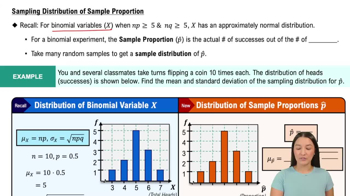A survey of 40 gym members from a large gym finds an average work out duration is 52 minutes. Is this a parameter or a statistic?
Table of contents
- 1. Intro to Stats and Collecting Data1h 14m
- 2. Describing Data with Tables and Graphs1h 55m
- 3. Describing Data Numerically2h 5m
- 4. Probability2h 16m
- 5. Binomial Distribution & Discrete Random Variables3h 6m
- 6. Normal Distribution and Continuous Random Variables2h 11m
- 7. Sampling Distributions & Confidence Intervals: Mean3h 23m
- Sampling Distribution of the Sample Mean and Central Limit Theorem19m
- Distribution of Sample Mean - Excel23m
- Introduction to Confidence Intervals15m
- Confidence Intervals for Population Mean1h 18m
- Determining the Minimum Sample Size Required12m
- Finding Probabilities and T Critical Values - Excel28m
- Confidence Intervals for Population Means - Excel25m
- 8. Sampling Distributions & Confidence Intervals: Proportion1h 12m
- 9. Hypothesis Testing for One Sample3h 29m
- 10. Hypothesis Testing for Two Samples4h 50m
- Two Proportions1h 13m
- Two Proportions Hypothesis Test - Excel28m
- Two Means - Unknown, Unequal Variance1h 3m
- Two Means - Unknown Variances Hypothesis Test - Excel12m
- Two Means - Unknown, Equal Variance15m
- Two Means - Unknown, Equal Variances Hypothesis Test - Excel9m
- Two Means - Known Variance12m
- Two Means - Sigma Known Hypothesis Test - Excel21m
- Two Means - Matched Pairs (Dependent Samples)42m
- Matched Pairs Hypothesis Test - Excel12m
- 11. Correlation1h 6m
- 12. Regression1h 50m
- 13. Chi-Square Tests & Goodness of Fit1h 57m
- 14. ANOVA1h 57m
1. Intro to Stats and Collecting Data
Intro to Stats
Problem 1.1.1
Textbook Question
Computer Virus In an AOL survey of Internet users, this question was posted online: “Have you ever been hit by a computer virus?” Among the 170,063 responses, 63% answered “yes.” What term is used to describe this type of survey in which the people surveyed consist of those who chose to respond? What is wrong with this type of sampling method?
 Verified step by step guidance
Verified step by step guidance1
Identify the type of survey: This survey is an example of a 'voluntary response sample' because it consists of individuals who chose to respond to the survey question.
Understand the nature of voluntary response samples: In voluntary response samples, participants self-select to be part of the survey, which can lead to biased results.
Explain the potential bias: The main issue with voluntary response samples is that they often attract individuals with strong opinions or experiences related to the survey topic, which may not represent the general population.
Discuss the impact of bias: Due to the self-selection bias, the results of the survey may not be generalizable to the entire population of Internet users, as those who have experienced a computer virus might be more inclined to respond.
Consider alternative sampling methods: To obtain more representative results, a random sampling method could be used, where every individual in the population has an equal chance of being selected for the survey.
 Verified video answer for a similar problem:
Verified video answer for a similar problem:This video solution was recommended by our tutors as helpful for the problem above
Video duration:
2mPlay a video:
Was this helpful?
Key Concepts
Here are the essential concepts you must grasp in order to answer the question correctly.
Voluntary Response Sample
A voluntary response sample is a type of non-probability sampling method where participants self-select to be part of the survey. This often leads to biased results because individuals with strong opinions or interests in the topic are more likely to respond, which may not represent the broader population accurately.
Recommended video:

Sampling Distribution of Sample Proportion
Sampling Bias
Sampling bias occurs when the sample collected is not representative of the population intended to be analyzed. In the context of voluntary response samples, the bias arises because the sample is skewed towards individuals who are more motivated to respond, often leading to overrepresentation of certain viewpoints and underrepresentation of others.
Recommended video:

Sampling Distribution of Sample Proportion
Non-Probability Sampling
Non-probability sampling refers to sampling techniques where not all members of the population have a chance of being selected. This contrasts with probability sampling, where every member has a known, non-zero chance of being chosen. Non-probability methods, like voluntary response sampling, can lead to biased results and limit the generalizability of the findings.
Recommended video:

Sampling Distribution of Sample Proportion

 2:13m
2:13mWatch next
Master Introduction to Statistics Channel with a bite sized video explanation from Patrick
Start learningRelated Videos
Related Practice
Multiple Choice
